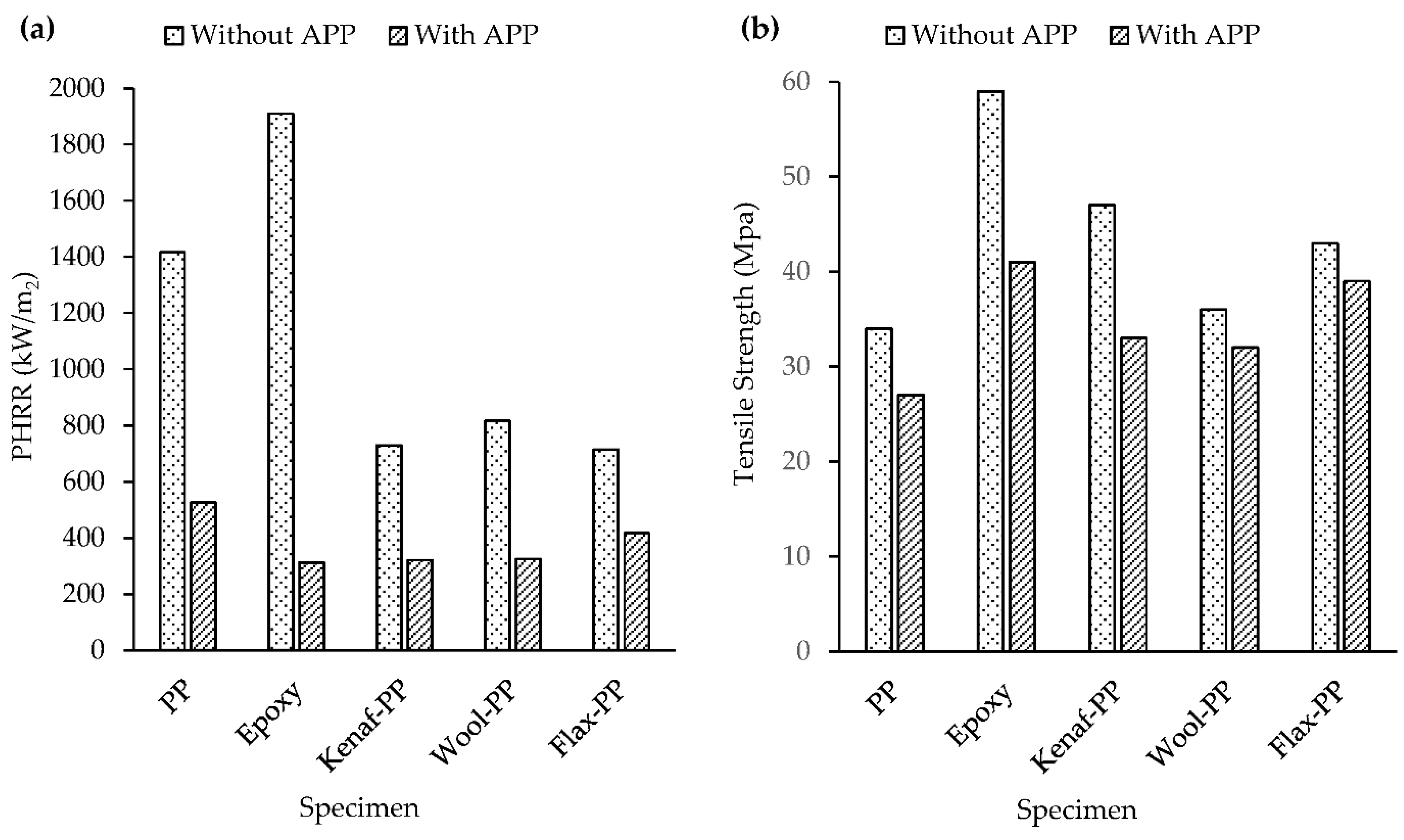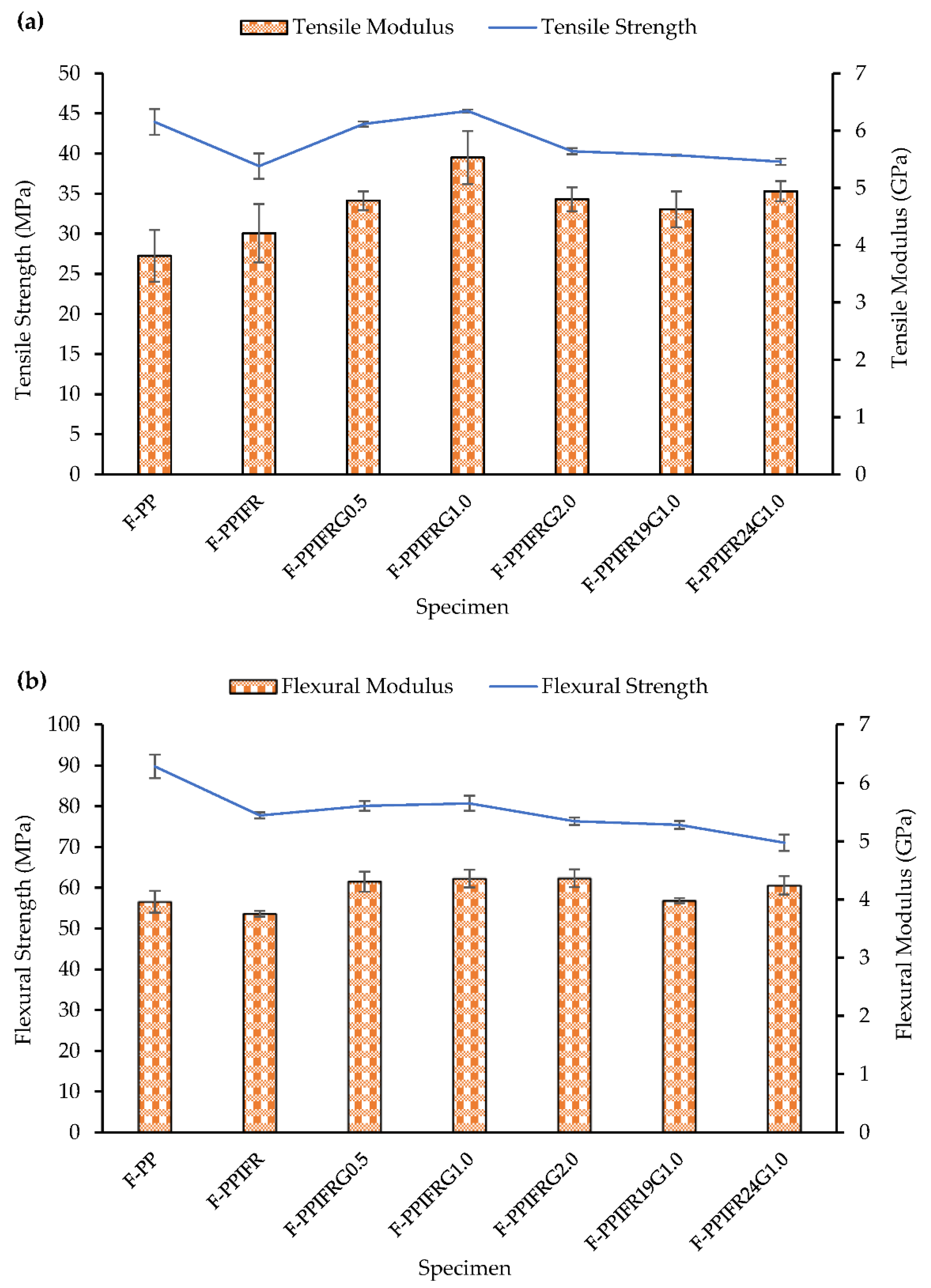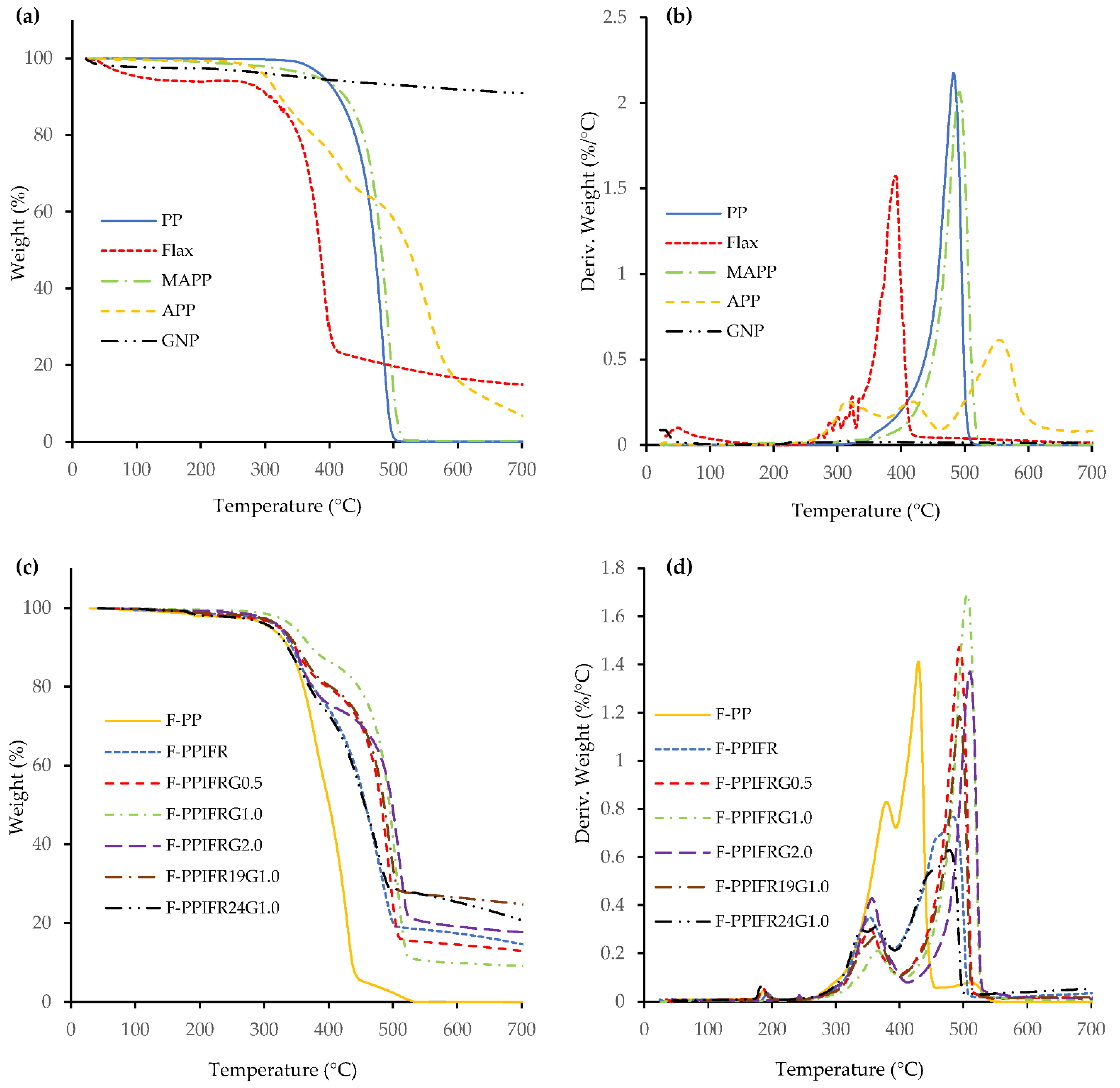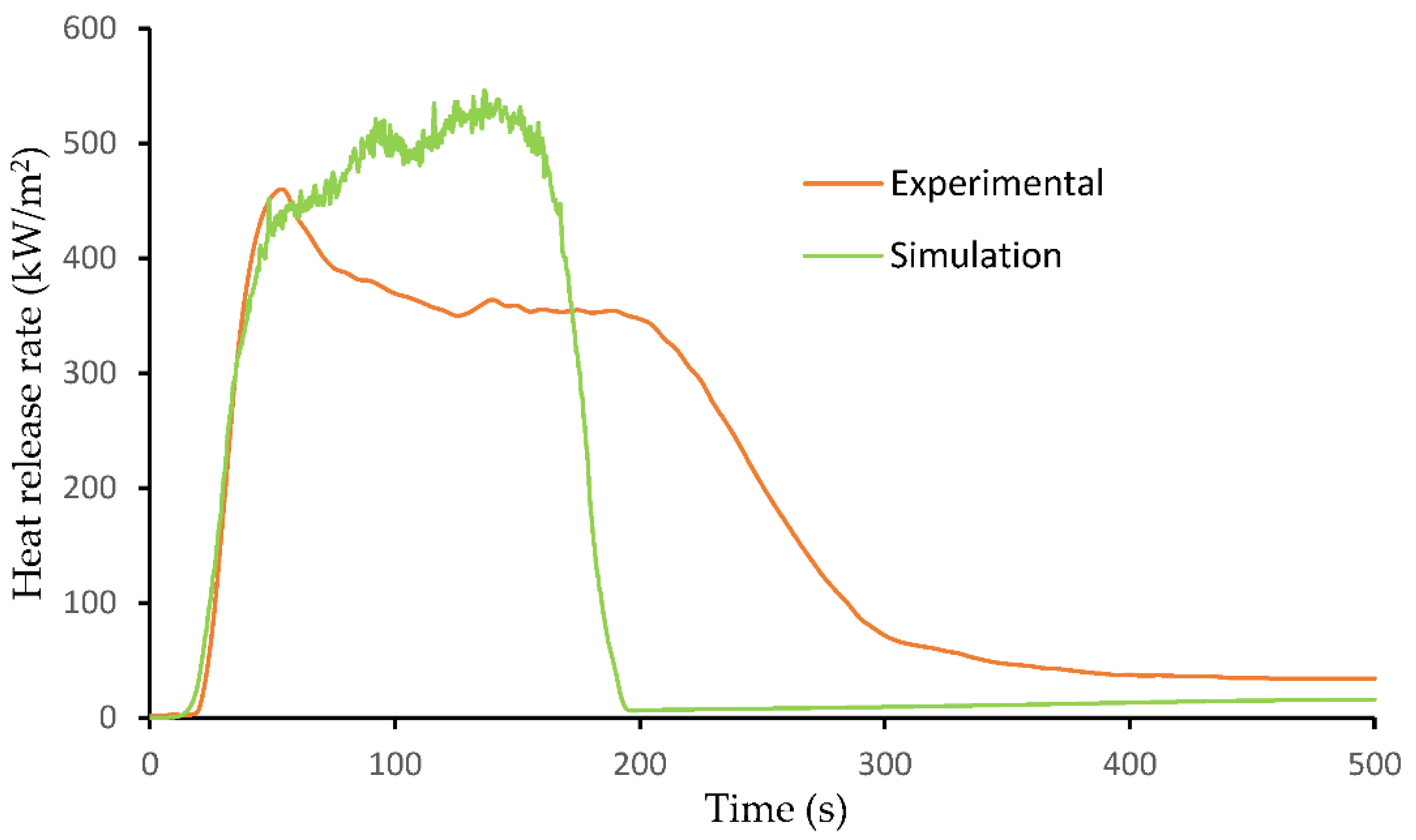Effects of Graphene Nanoplatelets on Mechanical and Fire Performance of Flax Polypropylene Composites with Intumescent Flame Retardant
Abstract
:1. Introduction
2. Results and Discussion
2.1. Mechanical Properties
2.2. Morphological Analysis
2.3. Cone Calorimeter Analysis
2.4. Thermogravimetric Analysis
2.5. Pyrolysis Model
3. Materials and Methods
3.1. Materials
3.2. Graphene Encapsulation
3.3. Composite Manufacturing
3.4. Characterisation
3.5. Cone Calorimeter
3.6. Mechanical Testing
3.7. Numerical Modeling
- Flax and PP/APP char residues were assumed to have the same thermophysical properties.
- Based on the TGA result, the char residue of F-PPIFR composite was measured to be 18 wt%. Therefore, PP was assumed to form char as a by-product due to reaction with APP in the numerical model, as shown in Table 5.
4. Conclusions
Author Contributions
Funding
Institutional Review Board Statement
Informed Consent Statement
Data Availability Statement
Acknowledgments
Conflicts of Interest
Sample Availability
References
- Gassan, J.; Bledzki, A.K. Thermal degradation of flax and jute fibers. J. Appl. Polym. Sci. 2001, 82, 1417–1422. [Google Scholar] [CrossRef]
- Saheb, D.N.; Jog, J.P. Natural fiber polymer composites: A review. Adv. Polym. Technol. 1999, 18, 351–363. [Google Scholar] [CrossRef]
- Wilkie, C.A.; Morgan, A.B. (Eds.) Fire Retardancy of Polymeric Materials, 2nd ed.; CRC Press: Boca Raton, FL, USA, 2010; pp. 15–42. [Google Scholar]
- Helwig, M.; Paukszta, D. Flammability of composites based on polypropylene and flax fibers. Mol. Cryst. Liq. Cryst. Sci. Technol. Sect. A Mol. Cryst. Liq. Cryst. 2000, 354, 373–380. [Google Scholar] [CrossRef]
- Hirschler, M.M. Fire Hazard and Toxic Potency of the Smoke from Burning Materials. J. Fire Sci. 1987, 5, 289–307. [Google Scholar] [CrossRef]
- Horrocks, A.R. An Introduction to the Burning Behaviour of Cellulosic Fibres. J. Soc. Dye Colour. 1983, 99, 191–197. [Google Scholar] [CrossRef]
- Chapple, S.; Anandjiwala, R. Flammability of natural fiber-reinforced composites and strategies for fire retardancy: A review. J. Thermoplast. Compos. Mater. 2010, 23, 871–893. [Google Scholar] [CrossRef]
- Ferdous, D.; Dalai, A.K.; Bej, S.K.; Thring, R.W. Pyrolysis of lignins: Experimental and kinetics studies. Energy Fuels 2002, 16, 1405–1412. [Google Scholar] [CrossRef]
- Kozłowski, R.; Władyka-Przybylak, M. Flammability and fire resistance of composites reinforced by natural fibers. Polym. Adv. Technol. 2008, 19, 446–453. [Google Scholar] [CrossRef]
- Subasinghe, A.; Bhattacharyya, D. Performance of different intumescent ammonium polyphosphate flame retardants in PP/kenaf fibre composites. Compos. Part A Appl. Sci. Manuf. 2014, 65, 91–99. [Google Scholar] [CrossRef]
- Kim, N.K.; Lin, R.J.T.; Bhattacharyya, D. Flammability and mechanical behaviour of polypropylene composites filled with cellulose and protein based fibres: A comparative study. Compos. Part A Appl. Sci. Manuf. 2017, 100, 215–226. [Google Scholar] [CrossRef]
- Li, B.; Xu, M. Effect of a novel charring-foaming agent on flame retardancy and thermal degradation of intumescent flame retardant polypropylene. Polym. Degrad. Stab. 2006, 91, 1380–1386. [Google Scholar] [CrossRef]
- Vuillequez, A.; Lebrun, M.; Ion, R.M.; Youssef, B. Effect of Phosphorus-Nitrogen Intumescent Flame Retardant on Structure and Properties of Poly (propylene). Macromol. Symp. 2010, 290, 146–155. [Google Scholar] [CrossRef]
- Tai, C.M.; Li, R.K.Y. Mechanical properties of flame retardant filled polypropylene composites. J. Appl. Polym. Sci. 2001, 80, 2718–2728. [Google Scholar] [CrossRef]
- Bai, G.; Guo, C.; Li, L. Synergistic effect of intumescent flame retardant and expandable graphite on mechanical and flame-retardant properties of wood flour-polypropylene composites. Constr. Build. Mater. 2014, 50, 148–153. [Google Scholar] [CrossRef]
- Lai, X.; Tang, S.; Li, H.; Zeng, X. Flame-retardant mechanism of a novel polymeric intumescent flame retardant containing caged bicyclic phosphate for polypropylene. Polym. Degrad. Stab. 2015, 113, 22–31. [Google Scholar] [CrossRef]
- Camino, G.; Lomakin, S. Intumescent materials. In Fire Retardant Materials; CRC Press: Boca Raton, FL, USA, 2001; pp. 318–336. [Google Scholar]
- Chen, B.; Gao, W.; Shen, J.; Guo, S. The multilayered distribution of intumescent flame retardants and its influence on the fire and mechanical properties of polypropylene. Compos. Sci. Technol. 2014, 93, 54–60. [Google Scholar] [CrossRef]
- Stark, N.M.; White, R.H.; Mueller, S.A.; Osswald, T.A. Evaluation of various fire retardants for use in wood flour-polyethylene composites. Polym. Degrad. Stab. 2010, 95, 1903–1910. [Google Scholar] [CrossRef]
- Lee, H.; Kim, N.K.; Jung, D.; Bhattacharyya, D. Flammability characteristics and mechanical properties of casein based polymeric composites. Polymers 2020, 12, 2078. [Google Scholar] [CrossRef]
- Rajaei, M.; Kim, N.K.; Bickerton, S.; Bhattacharyya, D. A comparative study on effects of natural and synthesised nano-clays on the fire and mechanical properties of epoxy composites. Compos. Part B Eng. 2019, 165, 65–74. [Google Scholar] [CrossRef]
- Deng, C.L.; Du, S.L.; Zhao, J.; Shen, Z.Q.; Deng, C.; Wang, Y.Z. An intumescent flame retardant polypropylene system with simultaneously improved flame retardancy and water resistance. Polym. Degrad. Stab. 2014, 108, 97–107. [Google Scholar] [CrossRef]
- Edwards, R.S.; Coleman, K.S. Graphene synthesis: Relationship to applications. Nanoscale 2013, 5, 38–51. [Google Scholar] [CrossRef]
- Salavagione, H.J.; Martínez, G.; Ellis, G. Graphene-Based Polymer Nanocomposites. In Physics and Applications of Graphene: Experiments; BoD–Books on Demand: Norderstedt, Germany, 2011. [Google Scholar]
- Mohan, V.B.; Krebs, B.J.; Bhattacharyya, D. Development of novel highly conductive 3D printable hybrid polymer-graphene composites. Mater. Today Commun. 2018, 17, 554–561. [Google Scholar] [CrossRef]
- Mohan, V.B.; Lau, K.T.; Hui, D.; Bhattacharyya, D. Graphene-based materials and their composites: A review on production, applications and product limitations. Compos. Part B Eng. 2018, 142, 200–220. [Google Scholar] [CrossRef]
- Mohan, V.B.; Bhattacharyya, D. Mechanical, electrical and thermal performance of hybrid polyethylene-graphene nanoplatelets-polypyrrole composites: A comparative analysis of 3D printed and compression molded samples. Polym. Technol. Mater. 2020, 59, 780–796. [Google Scholar] [CrossRef]
- El Achaby, M.; Arrakhiz, F.E.; Vaudreuil, S.; El Kacem Qaiss, A.; Bousmina, M.; Fassi-Fehri, O. Mechanical, thermal, and rheological properties of graphene-based polypropylene nanocomposites prepared by melt mixing. Polym. Compos. 2012, 33, 733–744. [Google Scholar] [CrossRef]
- Rafiee, M.A.; Rafiee, J.; Wang, Z.; Song, H.; Yu, Z.Z.; Koratkar, N. Enhanced mechanical properties of nanocomposites at low graphene content. ACS Nano 2009, 3, 3884–3890. [Google Scholar] [CrossRef]
- Kim, N.K.; Lin, R.J.T.; Bhattacharyya, D. Effects of wool fibres, ammonium polyphosphate and polymer viscosity on the flammability and mechanical performance of PP/wool composites. Polym. Degrad. Stab. 2015, 119, 167–177. [Google Scholar] [CrossRef]
- Yin, J.; Zhang, Y.; Zhang, Y. Deformation mechanism of polypropylene composites filled with magnesium hydroxide. J. Appl. Polym. Sci. 2005, 97, 1922–1930. [Google Scholar] [CrossRef]
- Kim, H.; Kobayashi, S.; AbdurRahim, M.A.; Zhang, M.J.; Khusainova, A.; Hillmyer, M.A.; Abdala, A.A.; Macosko, C.W. Graphene/polyethylene nanocomposites: Effect of polyethylene functionalization and blending methods. Polymer 2011, 52, 1837–1846. [Google Scholar] [CrossRef]
- Stankovich, S.; Dikin, D.A.; Dommett, G.H.B.; Kohlhaas, K.M.; Zimney, E.J.; Stach, E.A.; Piner, R.D.; Nguyen, S.T.; Ruoff, R.S. Graphene-based composite materials. Nature 2006, 442, 282–286. [Google Scholar] [CrossRef]
- Wang, X.; Song, L.; Pornwannchai, W.; Hu, Y.; Kandola, B. The effect of graphene presence in flame retarded epoxy resin matrix on the mechanical and flammability properties of glass fiber-reinforced composites. Compos. Part A Appl. Sci. Manuf. 2013, 53, 88–96. [Google Scholar] [CrossRef]
- Ramanathan, T.; Abdala, A.A.; Stankovich, S.; Dikin, D.A.; Herrera-Alonso, M.; Piner, R.D.; Adamson, D.H.; Schniepp, H.C.; Chen, X.R.R.S.; Ruoff, R.S.; et al. Functionalized graphene sheets for polymer nanocomposites. Nat. Nanotechnol. 2008, 3, 327–331. [Google Scholar] [CrossRef] [PubMed]
- Xu, Z.-Z.; Huang, J.-Q.; Chen, M.-J.; Tan, Y.; Wang, Y.-Z. Flame retardant mechanism of an efficient flame-retardant polymeric synergist with ammonium polyphosphate for polypropylene. Polym. Degrad. Stab. 2013, 98, 2011–2020. [Google Scholar] [CrossRef]
- Yuan, B.; Fan, A.; Yang, M.; Chen, X.; Hu, Y.; Bao, C.; Jiang, S.; Niu, Y.; Zhang, Y.; He, S.; et al. The effects of graphene on the flammability and fire behavior of intumescent flame retardant polypropylene composites at different flame scenarios. Polym. Degrad. Stab. 2017, 143, 42–56. [Google Scholar] [CrossRef]
- Dorez, G.; Ferry, L.; Sonnier, R.; Taguet, A.; Lopez-Cuesta, J.M. Effect of cellulose, hemicellulose and lignin contents on pyrolysis and combustion of natural fibers. J. Anal. Appl. Pyrolysis 2014, 107, 323–331. [Google Scholar] [CrossRef]
- Kim, N.K.; Bhattacharyya, D. Development of fire resistant wool polymer composites: Mechanical performance and fire simulation with design perspectives. Mater. Des. 2016, 106, 391–403. [Google Scholar] [CrossRef]
- Kim, N.K.; Dutta, S.; Bhattacharyya, D. Heat and smoke production of flax fibre reinforced composites under horizontal and vertical orientations. Compos. Part B 2019, 178, 107467. [Google Scholar] [CrossRef]
- Ngo, T.D.; Nguyen, Q.T.; Tran, P. Heat release and flame propagation in prefabricated modular unit with GFRP composite facades. Build. Simul. 2016, 9, 607–616. [Google Scholar] [CrossRef]
- Liou, T. Pyrolysis kinetics of electronic packaging material in a nitrogen atmosphere. J. Hazard. Mater. 2003, 103, 107–123. [Google Scholar] [CrossRef]
- Babrauskas, V.; Peacock, D.R. Heat release rate: The single most important parameter in fire hazard. Fire Saf. J. 1992, 18, 255–272. [Google Scholar] [CrossRef]
- Mouritz, A.P.; Gibson, A.G. Fire Properties of Polymer Composite Materials; Springer Science & Business Media: Berlin/Heidelberg, Germany, 2007. [Google Scholar]
- McGrattan, K.; Hostikka, S.; McDermott, R.; Floyd, J.; Weinschenk, C.; Overhold, K. Fire Dynamics Simulator User’s Guide (FDS), 6th ed.; Special Publication (NIST SP)-1019; NIST: Gaithersburg, MD, USA, 2013. [Google Scholar]
- Mcdermott, R. Fire Dynamics Simulator Technical Reference Guide Volume 1: Mathematical Model, 6th ed.; NIST: Gaithersburg, MD, USA, 2013; Volume 1. [Google Scholar]
- Yuen, A.C.Y.; Chen, T.B.Y.; Yeoh, G.H.; Yang, W.; Cheung, S.C.P.; Cook, M.; Yu, B.; Chan, Q.N.; Yip, H.L. Establishing pyrolysis kinetics for the modelling of the flammability and burning characteristics of solid combustible materials. J. Fire Sci. 2018, 36, 494–517. [Google Scholar] [CrossRef] [Green Version]
- Dutta, S.; Kim, N.K.; Das, R.; Bhattacharyya, D. Effects of sample orientation on the fire reaction properties of natural fibre composites. Compos. Part B Eng. 2019, 157, 195–206. [Google Scholar] [CrossRef]
- Dutta, S.; Das, R.; Bhattacharyya, D. A multi-physics framework model towards coupled fire-structure interaction for Flax/PP composite beams. Compos. Part B Eng. 2019, 157, 207–218. [Google Scholar] [CrossRef]







| Specimen | Cone Calorimeter Results | ||||||
|---|---|---|---|---|---|---|---|
| TTI (s) | PHRR (kW/m2) | TPHRR (s) | THR (MJ/m2) | FPI (m2s/kW) | CO (kg/kg) (±0.004) | CO2 (kg/kg) (±0.04) | |
| F-PP | 23.7 ± 1.5 | 677.7 ± 12 | 155 ± 1 | 118.2 ± 2.4 | 0.034 | 0.027 | 2.47 |
| F-PPIFR | 20 ± 2.6 | 459.5 ± 7 | 53.4 ± 2 | 89.9 ± 2.3 | 0.043 | 0.089 | 1.80 |
| F-PPIFRG0.5 | 20 ± 2 | 439.1 ± 16 | 56.7 ± 2.8 | 84.16 ± 4.6 | 0.045 | 0.101 | 1.74 |
| F-PPIFRG1.0 | 19.6 ± 1 | 442.8 ± 11 | 60 ± 0.5 | 88.6 ± 6 | 0.044 | 0.093 | 1.76 |
| F-PPIFRG2.0 | 19.7 ± 0.5 | 420.5 ± 12 | 56.7 ± 2 | 78 ± 1.4 | 0.046 | 0.091 | 1.07 |
| F-PPIFR19G1.0 | 23.2 ± 2 | 391.4 ± 1 | 60 ± 5 | 92.2 ± 3.1 | 0.065 | 0.106 | 1.58 |
| F-PPIFR24G1.0 | 25 ± 0.5 | 388 ± 8 | 58.3 ± 2 | 86.8 ± 0.9 | 0.064 | 0.096 | 1.57 |
| Specimen | T5% (°C) | Tmax1 (°C) | Tmax2 (°C) | Residue at 700 °C (wt%) |
|---|---|---|---|---|
| PP | 391 | 483 | - | 0 |
| Flax | 109 | 393 | - | 15 |
| APP | 302 | 318 | 550 | 10 |
| F-PP | 341 | 395 | - | 0.2 |
| F-PPIFR | 337 | 360 | 477 | 18 |
| F-PPIFRG0.5 | 330 | 360 | 497 | 18.5 |
| F-PPIFRG1.0 | 350 | 347 | 510 | 10.2 |
| F-PPIFRG2.0 | 330 | 360 | 515 | 19.5 |
| F-PPIFR19G1.0 | 330 | 352 | 495 | 23.5 |
| F-PPIFR24G1.0 | 316 | 345 | 475 | 21.6 |
| Constituent Content (wt%) | |||||
|---|---|---|---|---|---|
| Specimen | Flax | PP | MAPP | APP | GNP |
| F-PP | 29.41 | 67.05 | 3.53 | 0 | 0 |
| F-PPIFR | 25 | 57 | 3 | 15.0 | 0 |
| F-PPIFRG0.5 | 24.87 | 56.71 | 2.98 | 14.92 | 0.5 |
| F-PPIFRG1.0 | 24.75 | 56.43 | 2.97 | 14.85 | 1.0 |
| F-PPIFRG2.0 | 24.50 | 55.86 | 2.94 | 14.70 | 2.0 |
| F-PPIFR19G1.0 | 23.51 | 53.65 | 2.82 | 19.0 | 1.0 |
| F-PPIFR24G1.0 | 22.05 | 50.30 | 2.64 | 24.0 | 1.0 |
| Property | Unit | Materials PP | Flax | APP | Char Residue |
|---|---|---|---|---|---|
| Density | Kg/m3 | 900 | 1400 | 1900 | 550 |
| Emissivity | - | 0.97 | 0.85 | 0.94 | 0.93 |
| Specific heat capacity | kJ/kg K | 1.651 | 1.6 | 4 | 2 |
| Thermal conductivity | W/m K | 0.18 | 0.3 | 0.4 | 0.1 |
| Heat of combustion | kJ/kg | 4.9 × 104 | 9300 | - | - |
| Heat of reaction | kJ/kg | 1987 | 1411 | 880 | - |
| Reference temperature | °C | 482 | 391 | 625 | - |
| Heating rate | °C/min | 20 | 20 | 20 | - |
| Pyrolysis range | °C | 155 | 145 | 400 | - |
| Residue yield | kg/kg | 0.2125 | 0.15 | 0.1 | - |
| Number of reactions | 1 | 1 | 1 | 1 |
| Material | Constituent | Char Residue | Composite Char Contribution |
|---|---|---|---|
| (wt%) | (wt%) | (wt%) | |
| Flax | 25 | 15 | 3.75 |
| APP | 15 | 10 | 1.5 |
| PP | 60 | 21.25 | 12.75 |
Publisher’s Note: MDPI stays neutral with regard to jurisdictional claims in published maps and institutional affiliations. |
© 2021 by the authors. Licensee MDPI, Basel, Switzerland. This article is an open access article distributed under the terms and conditions of the Creative Commons Attribution (CC BY) license (https://creativecommons.org/licenses/by/4.0/).
Share and Cite
Ali, I.; Kim, N.K.; Bhattacharyya, D. Effects of Graphene Nanoplatelets on Mechanical and Fire Performance of Flax Polypropylene Composites with Intumescent Flame Retardant. Molecules 2021, 26, 4094. https://doi.org/10.3390/molecules26134094
Ali I, Kim NK, Bhattacharyya D. Effects of Graphene Nanoplatelets on Mechanical and Fire Performance of Flax Polypropylene Composites with Intumescent Flame Retardant. Molecules. 2021; 26(13):4094. https://doi.org/10.3390/molecules26134094
Chicago/Turabian StyleAli, Imran, Nam Kyeun Kim, and Debes Bhattacharyya. 2021. "Effects of Graphene Nanoplatelets on Mechanical and Fire Performance of Flax Polypropylene Composites with Intumescent Flame Retardant" Molecules 26, no. 13: 4094. https://doi.org/10.3390/molecules26134094







